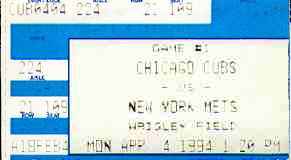Well, Wrigley Field still has less signage (modern euphemism for advertising) than any other ballpark. Actually, at one point during the broadcast, I think Bill Murray was joking with Chip and Steve about putting ads on the wall behind the ivy, at a reduced price, of course, since they’d only be visible in April and perhaps October. Or maybe it was Senator Dick Durbin doing the joking and not Bill Murray. I forget. What did come up during their conversation with the senator was a suggestion that he introduce legislation to force the Cardinals to trade Albert Pujols, preferably to the Cubs, or to the American League.
Anyway, here’s this week’s “Car Talk” puzzler, posted here because it happens to be baseball-related:
RAY: Lefty McDougal, star pitcher of the Kenosha Ramblers, had an incentive clause in his contract that guaranteed him an extra thousand bucks if he won 20 games during the season.
TOM: This sounds like 1925!
RAY: It’s last game of the season. Lefty has 19 victories, and is scheduled to be that day’s starting pitcher. The opponent is a lousy team. They’ve got a terrible record, and Lefty knows he’s going to get the bonus.
As luck would have it, an hour before the game his manager approaches him and says, “You ain’t starting, Lefty.”
Lefty asks, “Why not?”
The manager says, “The owner of the team came and said, ‘If you start this bum… if he throws even one pitch, you’re losing your job!'”
Lefty’s dejected. He says, “Jeez, I was going buy a new house in the Hamptons with that thousand bucks!”
Lefty’s discouraged, and the manager is discouraged too, because he has great regard for Lefty. The manager wonders, “How can I get Lefty to win his 20th game and collect his bonus– and not throw a single pitch?”
And that’s what happens. Lefty wins the game without throwing a single pitch.
How did he do it?
Original comments…
sandor: Here’s a guess. I’m not an expert on how win-lose records are figured, so I may have this wrong.
If the game is away, the Ramblers will bat first. Assuming they get a run in in the first inning, they’ll have the lead going into the bottom of the first. Lefty starts the game, but gets pulled for a reliever immediately before throwing a pitch. Assuming the reliever does his job, and the offense does theirs, and the Ramblers keep the lead for the entire game, wouldn’t Lefty get the win?
Levi: No–to get a win, a starting pitcher has to go five full innings.
The rules for relievers are much less solid, and I’m trying to come up with an answer. The problem I’m having is that so far, the only scenario I can come up with (pitcher comes in with 2 outs, runner on first in a tie game, picks him off, team takes lead in the bottom of the inning, he gets the win) is not a situation that the manager could plan for. And technically, that pitcher ought not to get the win, because the rule for awarding wins for relievers says that they should be the pitcher of record when the team goes ahead to stay, but it also mentions that, in a game featuring multiple pitchers, the win could be awarded to the pitcher who pitched most effectively. Wins are almost never parceled out that way, but in this case, I think even the official scorer might have to agree that a different pitcher deserved the win.
I’ll keep thinking.
Jim: I have here a link to a recent example of a pitcher getting the win without throwing a pitch. It’s similar but not identical to the situation Levi described, and it would still be hard to plan for.
Luke: Who gets the win in a forfeit? Maybe the manager persuades Lefty to offer half of his bonus to the other team if it forfeits.
Or maybe lefty balks four times to each batter, thus walking him, then picks him off the bag. He is left-handed, after all. He probably has a wicked move to first.
Luke, hanger-on: Oh, what happens when a starting pitcher dies after the game starts but before he’s thrown a pitch? Is it like when your roommate dies in college and you get a 4.0 for the quarter? (It’s probably a 5.0 now with grade inflation.) Assuming it’s a home game, let Lefty take the mound in the bottom of the first, then right as he’s about to start his wind-up, he takes a big lick of the hemlock he’s hidden in his glove, next to the emory board and Vaseline.
Luke, hanger-on: Well, what was the answer?
